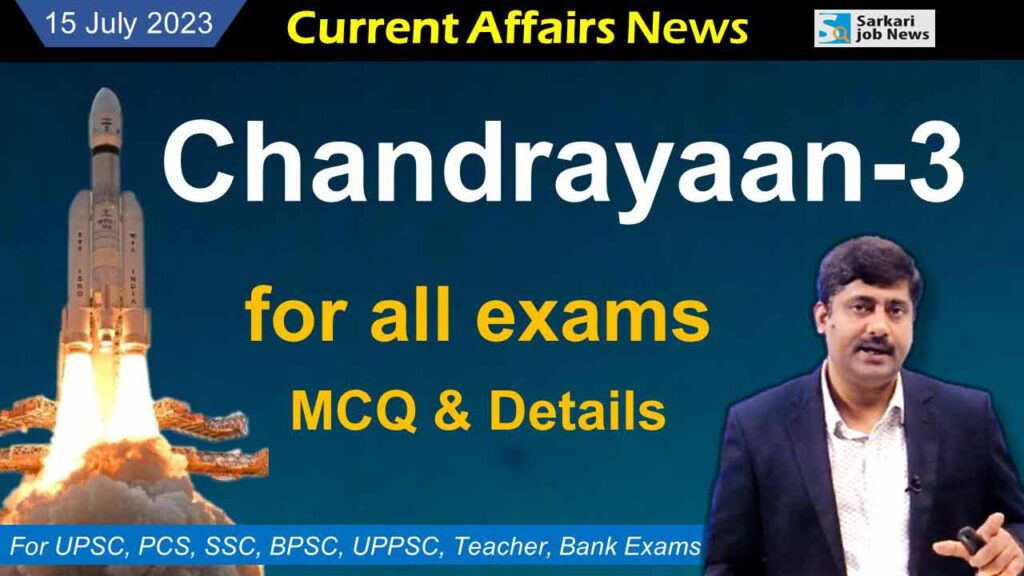This is the current affairs of 15 July 2023. Here are 10 questions and answers of daily current affairs for better preparation of competitive exams for government jobs.
PDF Download: Click here
1. Name the mission director of Chandrayaan-3?
a. M Srikanth
b. Ritu Verma
c. K Sivan
d. Rajendra Kumar
Answer: a. M Srikanth
Note – Mission Director for the launch of Chandrayaan-3 S. Mohana Kumar was However, after this, M. Srikanth played the role of Mission Director.
————-
2. Name the mission director for the launch of Chandrayaan-3?
a. Mohana Kumar
b. Ritu Verma
c. K Sivan
d. Rajendra Kumar
Answer: a. Mohana Kumar
Note – For the launch of Chandrayaan-3, Mission Director S. Mohana Kumar was However, after this, M. Srikanth played the role of Mission Director.
Scientist behind the success of Chandrayaan-3 mission
– Dr.S.Somnath (ISRO Chief)
– P. Veeramuthuvel (Project Director)
– M Srikanth (Mission Director)
– S. Mohana Kumar (Mission Director for the launch)
– Kalpana Kalahasti (Associate Project Director)
– V. Narayanan (Director of Liquid Propulsion Systems Center)
– M. Sankaran (Director of UR Rao Space Center)
– BN. Ramakrishna (ISTRAC Satellite, Navigation Director)
– S. Unnikrishnan Nair (Director of Vikram Sarabhai Space Center)
– Apart from these, there are other scientists who contributed a lot in this mission.
————–
2. With which rocket did ISRO launch Chandrayaan-3?
a. PSLV-M3
b. GSLV
c. LVM3-M4
d. SLV-3
Answer: c. LVM-3-M4 (Launch Vehicle Mark-3)

– Chandrayaan-3 was launched into space from the Satish Dhawan Space Center in Sriharikota, Andhra Pradesh, using the LVM3-M4 rocket on July 14, 2023.
– Its previous name was GSLV-III.
– This rocket is capable of launching 4,000-kilogram-class satellites into Geosynchronous Transfer Orbit (GTO) and 8,000-kilogram payloads into Low Earth Orbit (LEO).
– It is a three-stage launch vehicle.
– It has two solid propellant boosters on both sides.
– The main components include the L110 liquid stage and the C25 cryogenic stage.
————-
3. Tell the cost of Chandrayaan-3 mission?
a. 615 Crore Rupees
b. 978 Crore Rupees
c. 1000 Crore Rupees
d. 2200 Crore Rupees
Answer: a. 615 Crore Rupees
– On July 14, ISRO launched the spacecraft Chandrayaan-3 from the Satish Dhawan Space Center in Sriharikota, Andhra Pradesh.

– The budget for Chandrayaan-3 is reported to be 615 crore rupees.
– In comparison, Chandrayaan-2 had a cost of 978 crore rupees.
– In the case of Chandrayaan-2, there were three components: the orbiter, lander, and rover.
– The orbiter remained successful and is still orbiting the moon.
– So, this time when we are sending Chandrayaan-3, we are not using the orbiter because it is already present there. This saved the entire cost of the orbiter.
– The best thing about ISRO is that they do most of the work in-house. They develop a lot of the technology themselves, which allows us to execute major missions at a lower cost.
Regarding Chandrayaan-2:
– According to the Chandrayaan-2 mission, the Vikram lander was supposed to land on the lunar south pole between 1 a.m. and 2 a.m. on September 7, 2019, Indian Standard Time.
– It was about 2.1 kilometers away from the lunar surface when communication with ISRO was lost.
– However, the orbiter remained successful and is still orbiting the moon.
—————
4. In which part of the moon will the soft landing of Chandrayaan-3’s lander take place?
a. North Pole
b. South Pole
c. Tropic of Cancer
d. None of these
Answer: b. South Pole

– ISRO Chief S. Somanath stated after the launch of Chandrayaan-3 that the spacecraft has begun its journey towards the Moon. If everything goes according to plan, it will land on the Moon on August 23 at 5:47 PM.
Components of Chandrayaan-3:
– Chandrayaan-3 consists of a lander, rover, and propulsion module.
– The lander and rover will land on the lunar south pole and conduct experiments there for 14 days.
– The propulsion module will remain in lunar orbit and study the radiation coming from Earth.
– Through this mission, ISRO will determine how moonquakes occur on the lunar surface and study the lunar soil.
Total Weight:
– Chandrayaan-3 is equipped with one lander, one rover, and one propulsion module. The total weight is approximately 3,900 kilograms.
Omission of the Orbiter in Chandrayaan-3:
– The orbiter was not included in Chandrayaan-3.
– Instead, a homemade propulsion module was sent in its place.
– It will take the lander and rover to lunar orbit.
– Afterward, it will orbit around the Moon in a circular path approximately 100 kilometers above the lunar surface.
– The orbiter was not included because it will not conduct any specific studies of the Moon.
Scientific Instruments on the Lander and Rover:
– First: It will measure lunar quakes (Moonquakes).
– Second: It will determine how the lunar surface allows the flow of heat.
– Third: It will study the plasma environment.
– Fourth: It will precisely measure the distance between the Earth and the Moon.
– Fifth: It will search for minerals in the lunar soil.
What does plasma environment mean to detect?
– ISRO Chief S. Somnath says, “We know that there is no atmosphere on the moon. But this is not entirely true because gases are released from it. Instead, they get ionized and stay close to the surface. It changes with day and night. The lander of Chandrayaan-3 will measure the variations of the near-surface plasma density and its changes over time using the Radio Anatomy of Moon-Bound Hypersensitive Ionosphere and Atmosphere (RAMBHA).”
South pole of the Moon has been chosen for landing.
– ISRO scientists have chosen a challenging part of the Moon.
– The lander of Chandrayaan-3 will land on that surface of the Moon about which very little information is available.
– If it successfully lands, it will be a significant achievement for India.
– This part is called the lunar south pole. The special thing about it is that it is difficult to observe directly from Earth.
– There is a considerable possibility of the presence of water and other mineral substances here.
India will become the fourth country to land a spacecraft on the Moon.
– Until now, only three countries, the United States, Russia, and China, have successfully achieved soft-landing on the Moon.
– If the lander of Chandrayaan-3 successfully lands on the Moon, India will become the fourth country to do so.
– In this mission, India will land a lander on the surface of the Moon.
– The lander also includes a rover that will roam on the lunar surface and conduct experiments there.
– The lander will stay on the Moon for one lunar day. One lunar day is equivalent to about 14 days on Earth.
– It is necessary for the lander of Chandrayaan-3 to land on the lunar surface where sunlight is available.
– Sunlight is essential for the lander.
– On the Moon, the sun rises for about 14-15 days, followed by about 14-15 days of darkness.
What is the objective of Chandrayaan-3?
– In this mission, Chandrayaan will deploy a rover (a small robot) that will land on the surface of the Moon and position itself in the lunar south pole.
– The rover will explore this region to gather information about minerals, water, atmosphere, lunar tremors, and other relevant data that can be found on this part of the Moon.
– This exploration will be particularly valuable if we ever plan to establish colonies on the Moon in the future.
What are the major risks associated with such a mission?
– The first risk is that when you send a spacecraft to the Moon, it is entirely controlled by computers. As a human, sitting four lakh kilometers away, you cannot directly control it. It operates entirely with the help of artificial intelligence.
– The second challenge is that there is no GPS on the Moon. Just as we use GPS to navigate on Earth, autonomous cars rely on GPS technology. However, this doesn’t work on the Moon. You won’t know where you are, in which region you are, and how far you are. All this information needs to be estimated using onboard sensors. The good thing is that these aspects have been taken into consideration for this mission.
Important Details:
– Chandrayaan-3 launch date: July 14, 2023
– Launch vehicle: GSLV Mk-3
– Expected landing on the Moon: August 23
– Landing site: Lunar South Pole (Southern Hemisphere)
– ISRO Chief: S. Somnath
————–
5. Which medal did Nishad Kumar win in the Para Athletics World Championships 2023?
a. Gold
b. Silver
c. Bronze
d. none of these
Answer: b. Silver

Paralympian and high jumper Nishad Kumar won a silver medal in the ongoing World Para Athletics Championship in Paris on July 12, 2023.
————–
6. Who will become the new Supreme Court judge in July 2023?
a. Justice Ujjal Bhuiyan
b. Justice S. Venkatnarayan Bhatti
c. Justice Vivek Narayan
d. Both a and b
Answer: d. Both a and b
– Justice Ujjal Bhuyan has served as the Chief Justice of the Telangana High Court, and Justice S. Venkatanarayana Bhatti has served as the Chief Justice of the Kerala High Court.
– These appointments were made by the Supreme Court Collegium headed by Chief Justice of India, Justice D.Y. Chandrachud, and the recommendations of their names to the government were made immediately after.
– With these two new appointments, the number of judicial members in the apex court has increased to 33, with only one position remaining vacant.
—————
7. Indigenous Global Navigation Satellite System (DGNSS) What is the purpose of Sagar Sampark?
a. Navigation at sea
b. Fish tracking in the sea
c. Trench tracking in the sea
d. Nnavigation in the mountains
Answer: a. Navigation at sea
– The indigenously developed Differential Global Navigation Satellite System (DGNSS) called “Sagar Sampark” was launched by Union Minister Sarbananda Sonowal.
– Sonowal holds the Ministry of Ports, Shipping, and Waterways.
Sagar Sampark:
– The primary objective of the DGNSS system is to enhance and strengthen the ongoing digital transformation in the Indian maritime domain.
– The DGNSS system significantly improves navigation safety by reducing the risks of collisions, grounding, and accidents.
– It ensures the seamless availability of accurate information for safe navigation, ensuring efficient communication between ports and vessels in port areas.
————–
8. Which space agency has identified the most active supermassive black hole in a distant galaxy named CEERS 1019?
a. ISRO
b. NASA
c. Europa
d. none of these
Answer: b. NASA
– NASA’s James Webb Space Telescope has identified an active supermassive black hole, which is the farthest black hole discovered to date.
– The host galaxy of this black hole, CEERS 1019, has been alive for more than 570 million years since a major explosion.
—————
9. In which country the multinational maritime security exercise named ‘Operation Southern Readiness 2023’ took place, where Indian warship INS Sunayna took part?
a. Italy
b. Britain
c. Seychelles
d. America
Answer: c. Seychelles
– This maritime exercise took place in Seychelles from 10th to 12th July 2023.
– It is an international initiative aimed at enhancing maritime security and combating maritime piracy to ensure security and freedom of navigation in the region.
– India, the United States, Italy, Britain, Seychelles Navy, and Maritime Police participated in this exercise.
—————
10. Who was elected as the Secretary General of NATO for the third time in a row?
a. Jens Stoltenberg
b. Jacobus Robert
c. Bill Clinton
d. none of these
Answer: a. Jens Stoltenberg
– After having his mandate extended, NATO Secretary General Jens Stoltenberg will lead NATO for another year.
– Born in Norway, Stoltenberg is an economist by profession and has previously served as the Prime Minister.

